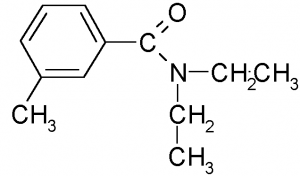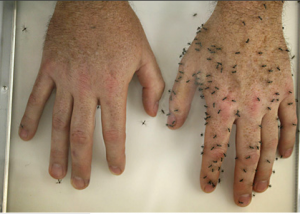 N,N-diethyl-meta-toluamide is more commonly known as the chemical DEET and it is used by nearly 100 million people per year in the United States alone. Developed for the military in 1946 it wasn’t made for public use until 1957. There are about 150 products that contain DEET available to you and I and have anywhere from 4% to 100% of this active ingredient. There is no age restriction on the use of this product as studies show no ill effects to children if the user follows the instructions on the label. According to the EPA there are no undesirable side effects in the short term use of DEET but if any adverse reactions occur you should wash it off and seek medical attention.
N,N-diethyl-meta-toluamide is more commonly known as the chemical DEET and it is used by nearly 100 million people per year in the United States alone. Developed for the military in 1946 it wasn’t made for public use until 1957. There are about 150 products that contain DEET available to you and I and have anywhere from 4% to 100% of this active ingredient. There is no age restriction on the use of this product as studies show no ill effects to children if the user follows the instructions on the label. According to the EPA there are no undesirable side effects in the short term use of DEET but if any adverse reactions occur you should wash it off and seek medical attention.
Although DEET is universally accepted as a excellent mosquito repellant scientist are still debating  just how it works. You would think this would have been something they figured out back in 46 but apparently they were just happy with the results or maybe came to a conclusion that later was disproved but not replaced with the correct answer. In any event it is something that hasn’t been much improved on for some 63 years.
just how it works. You would think this would have been something they figured out back in 46 but apparently they were just happy with the results or maybe came to a conclusion that later was disproved but not replaced with the correct answer. In any event it is something that hasn’t been much improved on for some 63 years.
How DEET works; Theory One
The first camp of scientists theory is that the chemicals in DEET block the receptors of mosquitos and they simply cannot detect you. This idea is the one most accepted even though we know that mosquitos and other blood sucking pests find their prey by body heat, visually, carbon dioxide (or breath) and odors. On the surface you might be hard pressed to explain that mere ‘blocking’ of their receptors could repel a pest who can hone in on your heat and also see you but I could easily understand the masking of odors or c02. I’m no scientist and for years I believed this theory without giving it much thought and for 50 years it has not been challenged for probably the same reason.
How DEET works; Theory Two
 Just in the recent months researches from the University of California,Davis have come up with what they believe to be the answer. It does have something to do with odor but not the masking of it or the jamming of the mosquitos senses but rather it just makes you smell bad to the mosquito and they simply avoid you.
Just in the recent months researches from the University of California,Davis have come up with what they believe to be the answer. It does have something to do with odor but not the masking of it or the jamming of the mosquitos senses but rather it just makes you smell bad to the mosquito and they simply avoid you.
When explaining the methods used one researcher put it this way;
First they identified a single olfactory neuron on one of the bug’s antennas that responded to DEET. Then, using a different way to deliver the chemicals to the mosquitoes, they tested the neuronal response first with the attractant alone and then in combination with DEET. There was no difference in response, suggesting that the DEET had not affected the receptor. “This clearly shows that there was no jamming,” Dr. Leal said.
Ordinarily this wouldn’t be such a big deal to you or I but in the mind of a scientist it can open up a whole new way to approaching pest control solutions. Researchers can now work with other chemicals that can achieve this goal that may be even more effective and work on a wider array of insects. Perhaps in the near future we may simply hang a small pellet around our neck or put it in our pocket rather than slathering up all our exposed skin with the aerosol spray. Maybe pests such as bed bugs in hotel rooms can be held at bay with something that produces a noxious smell that only they can sense. Time will tell but for now it seems we’ve added another brick to the foundation that was laid over 60 years ago.




